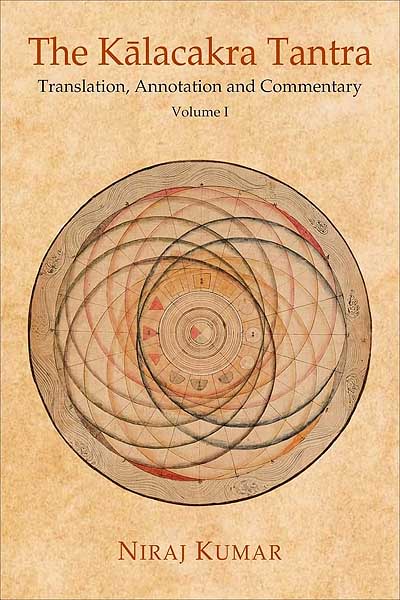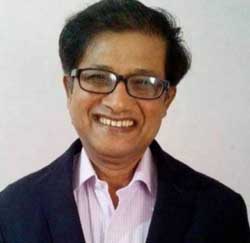 |
The Kalacakra Tantra,
Translation, Annotation and Commentary, Vol. I,
by Niraj Kumar,
D. K. Printerworld (P) : New Delhi, 2022, pp. IX-615.
|
 The Kālacakra belongs to the class of Highest Yoga Tantra and was originally given by Shakyamuni Buddha to the Dharma King of Shambhala, Suchandra. This was the last major Tantra text written in India before Buddhism declined during the thirteenth century. The book has left a long lasting influence over the Himalayan region, Tibet, and Mongolia in the last thousand years of its journey. Apart from the commentary, the Vimalaprabha Tika, written during the middle of the eleventh century, there is no verse commentary available to the general reader. The last major attempt was made by a Nyingma scholar from Bhutan, Mipham(1846-1912CE). Several attempts have been made by the western scholars since early nineteenth century to translate the full text. This is yet to be achieved. In this context Mr. Niraj Kumar has translated of all the 1,047 verses of the Kālacakra Tantra from original Sanskrit, and also written a detailed commentary using ways of understanding. The word by word meaning too has been provided. A number of visual tools have been employed for better understanding by our younger generation.
The Kālacakra belongs to the class of Highest Yoga Tantra and was originally given by Shakyamuni Buddha to the Dharma King of Shambhala, Suchandra. This was the last major Tantra text written in India before Buddhism declined during the thirteenth century. The book has left a long lasting influence over the Himalayan region, Tibet, and Mongolia in the last thousand years of its journey. Apart from the commentary, the Vimalaprabha Tika, written during the middle of the eleventh century, there is no verse commentary available to the general reader. The last major attempt was made by a Nyingma scholar from Bhutan, Mipham(1846-1912CE). Several attempts have been made by the western scholars since early nineteenth century to translate the full text. This is yet to be achieved. In this context Mr. Niraj Kumar has translated of all the 1,047 verses of the Kālacakra Tantra from original Sanskrit, and also written a detailed commentary using ways of understanding. The word by word meaning too has been provided. A number of visual tools have been employed for better understanding by our younger generation.
The book provides an unparalleled insight into the nature of space and time as the Ultimate reality. The text deals with external cycles of galactic rhythms of time expounded by the Tibetan calendar. These cycles influence internal cycles of the subtle body and reverberate between alternative cycles. In explaining these rhythms the text draws very heavily from the diverse disciplines. The cognitive concepts on space and time are intricately woven with complex mathematical formulae and equations, algorithms, planetary philosophy, predictive astrology and technical details about cosmology, geo-scapes, esoteric systems of knowledge and structure of microcosm, yoga, eschatology, phonetic system of mantras, zodiac signs and planetary movements. Within the intricate mesh of ideas the aspiring adept is required to attain salvation by charting his or her destiny from the impermanence of life. The aim of the Kālacakra is to immortalize the self not by withdrawing from life but by cognizing and living through the mechanics of cycles through a lifelong practice of pranic-yoga which is a micro link to macrocosm. There is so much going on in the text that it is difficult to enter its secrets without initiation by a qualified guru.
Divided into the four chapters followed by eight appendices and a detailed bibliography ,Mr. Niraj Kumar provides a thorough translation of each verse and meticulously unravels its enigmatic contents. Diving deep into the Sanskrit texts of the Kālacakra tradition , Kumar attempts to locate the region of Sambhala, based upon texts and the astronomical data internally available within the text ; as also Oddiyana. There is a special connection between the Kālackara and the land of Sambhala with regard to a future golden age of Dharma that carries a profound message for allthe people on earth at the time in history. It explores the details of the Kalki kings. The historical figures and their role in evolution of this system have been chronologically described. Thus it is rehumanization of the history of Kālacakra philosophy .
The realization of bliss is also expressed to be Sahaja that spread from the Kālachakra Tantra to Sahajiyā Buddhism – unique in Bengal continued in symbiosis with growing Bhakti movement of Vaiṣṇiavism and with the mystical Sufi, and giving birth to the syncretic Bāuls of Bengal. Despite the efforts of various actors in Indian history to create boundaries between them, they are not properly bounded entities. They are forever intertwined, often blurring into one another in practice reflecting as part of an ongoing dialectic between two contrasting religious orientations.Their efforts and vision have nonetheless left a remarkable and enduring legacy. Refuting the distinction betweenKālacakrayāṇa, Sahajayāṇa, and Vajrayāṇa that this differentiation is artificial and not in use in Tibetan tradition, the author offers a very productive approach to understanding those communities and South Asian social and religious history more broadly.
The text postulates a pan-psychic world view where everything is alive and conscious – from atomic to biological beings and emptiness to cosmic beings. Everything breaths, through which Time( Kāla)in its descriptive mode operates. But on the other hand, this philosophy also takes about the ubiquitous presence of machines. Further, the book delves into the utility of the philosophy at this juncture when man-machine integration at hand reflecting thereby the Kālacakra philosophy can become a proto-template of transcendence for a man-machine integrated future.Nowadays, there is a lot of talks about the need for world peace. Nevertheless, it is not happening. Why is it not happening ? Because as long as minds are still dominated by such mental distortions as attachment and anger, peace is impossibility. Anger and other mental distortions decrease through the practice of the Buddha’s teachings. So, wehave the possibility to do something efficacious for world peace by subduing these mental distortions in our own minds. Further, while engaging in the practice oneself, if one encourages other people who are not in the Dharma to enter into practice, this is also very helpful and important to attain salvation and immortalizing the self.
The author provides a thorough translation of each verse and meticulously unravels its enigmatic contents. He decodes the complex verses and offers his own exegesis on each of the concepts. To clarify esoteric subjects, he provides mathematical equations, algorithms, diagrams of planetary movements, These are analytical tools to clarify the complexity of the structured cosmology envisioned by the ancient seers. The author has ably scrutinized all the aspects of the concepts. He provides an excellent interpretation to the scope and depth of the Kālacakra tradition. The author has done full justice to the complexity of the text. The work unquestionable makes a major contribution to the almost lost tradition of Kālacakrayāṇa. So wide-ranging in importance and so carefully crafted and broadly researched, this is a book will turn to for many years to come- both for its own special contribution and for a basic orientation to the field. An indispensable book for the practitioner of Tantric Buddhism. No doubt the author deserves to be congratulated for his outstanding contribution to further our understanding about the esoteric culture of Buddhism.
*Associate Professor, Deptt. of History,T.M.Bhagalpur University, Bhagalpur-812007
